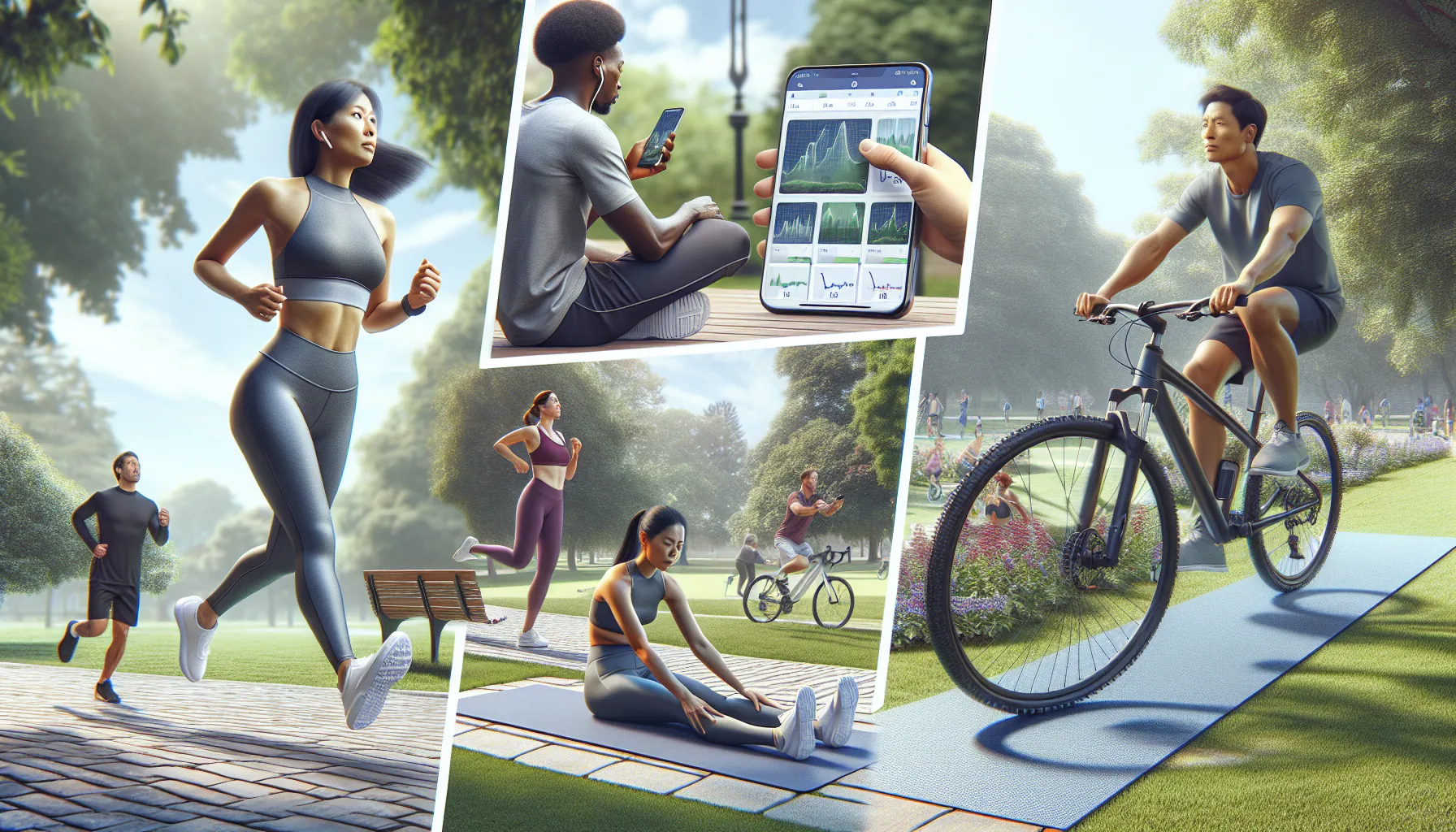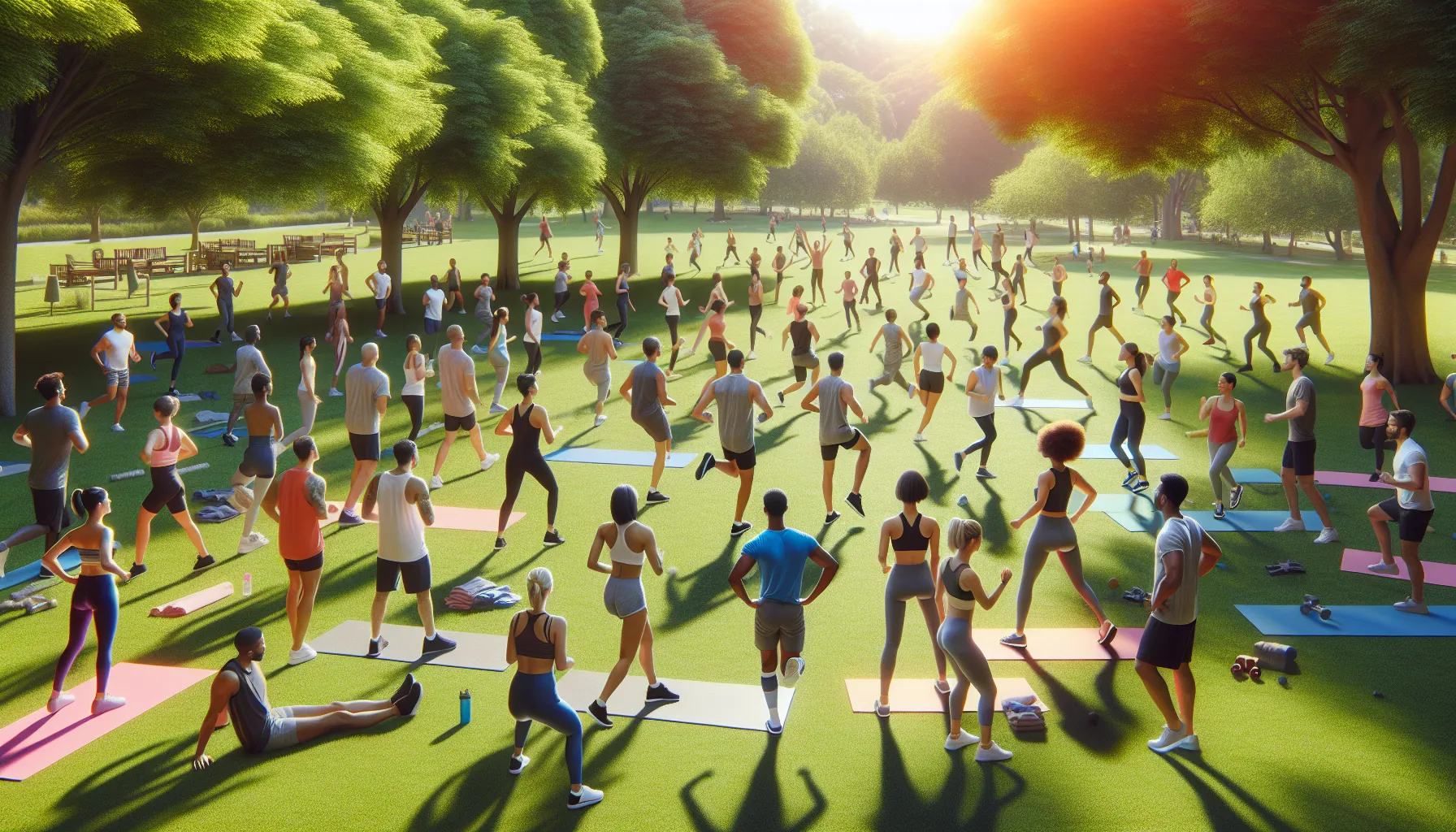Staying active has never been easier now that we’ve got fitness apps right at our fingertips. Whether we’re just starting our fitness journey or pushing for new personal bests these apps help us track progress and stay motivated every step of the way. With a few taps on our phones we can access guided workouts set goals and even connect with friends for a bit of healthy competition.
We all have different routines and preferences but there’s an app out there for everyone. From running and yoga to strength training and nutrition tracking these digital tools make it simple to fit exercise into our busy lives. Let’s explore how the right fitness app can transform our approach to health and help us reach our goals faster than ever.
Overview of Apps for Fitness
Apps for fitness have transformed the way we approach exercise, making it more accessible and customizable than ever before. Our smartphones now serve as constant workout companions, offering everything from guided workouts and step counters to in-depth analytics and tailored meal plans. Whether our focus is weight loss, muscle building, flexibility, or general health, there is an app designed to support us.
Fitness apps generally fall into a few popular categories. Activity trackers log our movement and exercise, counting steps, workouts, calories burned, and sometimes even sleep. Workout apps offer guided routines with video or audio instructions, covering everything from high-intensity interval training (HIIT) to yoga and pilates. Nutrition apps help us stay on track with our diet by logging meals, tracking macros, and providing healthy recipe suggestions. There are also hybrid apps that combine multiple features for an all-in-one experience.
Most modern fitness apps integrate with wearable devices like fitness bands and smartwatches. This integration allows for seamless syncing of heart rate data, exercise stats, and sleep patterns. Many platforms allow us to set personalized goals, monitor changes over time using intuitive progress charts, and receive real-time feedback during our workouts. Push notifications and friendly reminders are built-in to help us stay consistent, which is essential for long-term results.
A standout feature of many top apps is their community aspect. Social integration encourages us to share achievements, participate in challenges, and engage with others for motivation and accountability. Apps like Strava and Fitbit cultivate a sense of friendly competition through leaderboards and group challenges, making solo routines feel social.
Accessibility is another key advantage. We can find apps tailored to all experience levels, physical conditions, budget ranges, and time constraints. Most apps offer a free tier with basic tracking or sample workouts, while premium upgrades unlock advanced analytics, personalized coaching, or comprehensive workout programs. This tiered structure gives us flexibility to try out different platforms before committing financially.
Fitness apps continue to evolve with new technologies like AI-driven coaching, adaptive workout plans, and video streaming. These advancements create increasingly personalized experiences. For example, some apps now use artificial intelligence to adjust our routines based on real-time performance or recovery needs, making recommendations that match our unique capabilities and goals.
Choosing the right app often comes down to the features that matter most to us. Those who value simplicity and quick tracking might prefer minimalist apps like Google Fit or Apple Health. For structure and progression, digital coaching platforms like Nike Training Club or Freeletics provide disciplined workout plans. Nutritionally focused users may gravitate to apps like MyFitnessPal or Lose It! for in-depth food tracking and meal planning. Those drawn to mindfulness and balancing stress may find yoga and meditation guidance through apps like Daily Yoga or Calm.
The versatility and sheer range of apps for fitness mean that we can tailor our digital wellness toolkit to fit our lifestyle, preferences, and evolving goals. The right blend of usability, personalization, and community engagement is what sets top-performing apps apart in an increasingly competitive digital fitness landscape.
Key Features to Look For

Selecting the best fitness app often comes down to the features it offers and how well those features align with our unique fitness journey. Let’s break down the core elements that set leading fitness apps apart from the crowd.
Workout Tracking and Customization
A standout fitness app lets us track every workout detail while granting full control over the structure of our routines. The ability to log a range of activities—from simple walks to complex weightlifting sessions—sets a solid foundation for progress tracking. These apps typically let us set goals based on distance, time, calories burned, or intensity.
Customizable workout plans are vital. Top-rated apps provide pre-designed programs for various fitness levels but also let us adapt or build routines from scratch. We value apps that let us swap exercises, tweak sets and repetitions, and save favorite workouts for quick access. Some apps offer video demonstrations and detailed form cues, ensuring workouts are both flexible and safe for users at every stage.
Integration With Wearables and Devices
Fitness tracking goes beyond manual input now. Modern apps excel by seamlessly syncing data from smartwatches, heart rate monitors, and other wearable devices. This integration ensures our step counts, heart rate zones, and sleep patterns automatically merge with our activity logs.
Many apps partner with established platforms like Apple Health, Google Fit, Fitbit, and Garmin. This feature creates a holistic view of our health, capturing everything from daily movement to sleep quality in one place. We look for apps that allow easy connection processes and display real-time stats during workouts. Accurate syncing and continuous monitoring are essential for users who rely on data-driven feedback to optimize performance and recovery.
Nutritional Guidance and Meal Plans
Comprehensive fitness goes beyond exercise, and we appreciate apps that deliver robust nutritional guidance in tandem with workout features. Leading apps offer barcode scanning for packaged foods, vast ingredient databases, and daily nutrient breakdowns. Some include features for tracking hydration, macronutrients (proteins, carbs, fats), and micronutrients (vitamins and minerals).
Meal plan customization stands out. Good apps let us adjust calorie targets, flag allergens, pick dietary preferences (such as vegan, gluten-free, or keto), and swap individual meals. Some apps go a step further by generating grocery lists and offering recipe suggestions based on user goals. This holistic approach simplifies healthy eating and builds habits that complement our active routines.
Community and Social Features
Fitness journeys are often more successful with a support system. The best apps foster communities where users can share achievements, join group challenges, and celebrate milestones together. This can be as simple as integration with social media for sharing progress or as involved as in-app forums, private messaging, and digital workout buddies.
Leaderboards, group fitness challenges, and badge rewards encourage motivation and accountability. When apps allow us to connect with friends or find local workout groups, it boosts our sense of belonging and commitment. Some provide live classes or allow users to create custom challenges, deepening the social experience and making workouts more engaging.
Personalized Coaching and Feedback
Personalized coaching takes fitness apps to a whole new level. The best platforms go beyond generic plans and use AI or coaching algorithms to provide feedback tuned to our performance and habits. This may include adapting workout intensity, suggesting rest days, pointing out form issues, or recommending specific exercises based on our results.
Interactive feedback—whether through real-time audio cues, post-workout summaries, or progress reports—empowers users to correct course and stay motivated. High-end apps sometimes offer options for live chat or video calls with certified trainers, making expert guidance accessible outside of traditional gyms. Over time, this tailored approach helps users avoid plateaus, prevent injuries, and continually reach for new goals.
Popular Apps for Fitness: A Closer Look

With so many fitness apps on the market, choosing the right one can feel overwhelming. Our closer look at popular apps highlights key differences in cost, features, and accessibility.
Free vs. Paid Fitness Apps
Fitness apps generally fall into two price categories: free or paid. Free apps appeal to beginners or budget-conscious users. These often include core features like step tracking, simple workout logs, or basic guided routines. For example, Google Fit and MyFitnessPal both offer free tiers that handle basic tracking for steps, workouts, and calories.
Paid apps or premium subscriptions unlock a broader range of features. These may include personalized coaching, adaptive workout plans, advanced performance analytics, and exclusive content like video classes. Nike Training Club once required a membership for premium content but now offers most of its library to all users for free. In contrast, apps like Fitbit Premium or Peloton require monthly fees for access to in-depth stat analysis, guided programs, and interactive leaderboards.
Below is a breakdown of several top fitness apps comparing their free and paid offerings:
| App Name | Free Features | Paid Features | Price Range |
|---|---|---|---|
| MyFitnessPal | Calorie tracking, food log, limited recipes | Meal plans, macro tracking, deeper analytics | $0 / $19.99 mo |
| Strava | Basic run/bike tracking, community features | Segment leaderboards, route planning, training log | $0 / $11.99 mo |
| Nike Training Club | Bodyweight workouts, yoga, video library | Nutrition tips, expert programs | $0 (most content free) |
| Fitbit app | Step/activity logs, nutrition, basic insights | Sleep scores, stress tools, advanced health metrics | $0 / $9.99 mo |
| Peloton App | 30-day free trial, selected live classes | Full library, live/on-demand classes, training plans | $12.99 mo |
Free fitness apps are great for simple tracking and motivation, but users who outgrow basic features often find value in upgrading. Paid tiers are best for those wanting structured programs or detailed data for training improvements. Some apps use a “freemium” model, so everyone can start exploring at no cost and decide later if premium features justify the expense.
App Availability Across Platforms
The best fitness apps offer compatibility across multiple devices and operating systems for seamless logging and data sync. Core platforms include iOS for iPhones and Apple Watch, Android for smartphones and Wear OS watches, plus a growing number of smart TVs, web clients, and even fitness-focused wearables like Garmin or Fitbit devices.
We have noticed standard-setting fitness apps adopt cross-platform availability:
- Apple Health and Google Fit both integrate natively with their respective operating systems, supporting syncing across phones, watches, and connected apps.
- Strava is available on iOS, Android, and even desktop browsers, with additional support for bike computers and GPS watches. It automatically logs data from Suunto, Garmin, and Wahoo devices.
- Nike Training Club covers smartphones, Apple TV, and supports Apple Watch for in-workout cues and metrics. While Android users can access most features, Apple Watch integration gives iOS a slight edge.
- Fitbit app delivers robust syncing with all Fitbit devices, and users can access the app on iOS, Android, and via web dashboard. Premium features unlock on any platform with a single subscription.
- Peloton App reaches across iOS, Android, Fire TV, Roku, Chromecast, and supports Apple Watch for tracking metrics in real time. This flexibility appeals to users who want to train at home, outdoors, or at the gym.
Platform compatibility is crucial if we prioritize syncing wearable data—such as heart rate, sleep, or steps—into our app. Those who own multiple devices or share data with other wellness apps benefit from broader reach and interoperability. However, app performance may vary by device. For instance, certain features optimized for Apple Watch may not be available on Wear OS watches or less popular brands.
Ultimately, platform flexibility and device compatibility can make or break the fitness app experience. Checking if the app supports our current (and future) devices helps ensure we get the most convenience and data accuracy from our fitness journey.
Performance and User Experience

Fitness apps succeed or fail based on how smoothly they fit into our daily routines and how much value they deliver with consistent use. A solid experience is just as important as the features or the price. Let’s break down how leading fitness apps stack up on ease of use, program flexibility, and motivation tools.
Ease of Use and Interface Design
A well-designed fitness app should let us get started without confusion or frustration. Top apps like MyFitnessPal, Nike Training Club, and Strava have put a lot of thought into their interfaces. We see large icons, guided onboarding, and clear navigation. This reduces barriers for new users and streamlines the process for experienced fitness enthusiasts.
For example, MyFitnessPal makes calorie tracking intuitive with its barcode scanning and auto-complete search. Nike Training Club welcomes us with tailored workout suggestions based on initial profile questions. Strava offers a single-tap start for tracking outdoor activities, which is perfect when we are eager to get moving.
Some apps miss the mark with cluttered screens, slow load times, or confusing workflows. However, premium apps tend to invest more in user testing and interface updates. We have noticed that apps supporting both light and dark mode, like Fitbit and Apple Fitness, offer an easy-on-the-eyes experience in any lighting conditions.
The best apps allow us to customize the home screen, pin favorite workouts, or reorder tiles to match our priorities, making our fitness journey more personal. Accessibility options, such as large text or voice instructions, are being adopted more widely—a big win for inclusivity.
Exercise Library and Program Variety
The depth and flexibility of exercise libraries make a major difference in our fitness journeys. Whether our goals are strength, endurance, flexibility, or complete wellness, a diverse catalog is essential. Most leading apps provide hundreds to thousands of workouts, ranging from high-intensity interval training (HIIT) and strength training to yoga and guided meditation.
Peloton and Nike Training Club stand out by offering both on-demand and live classes led by professional trainers. This variety keeps motivation high and boredom low. Some apps, such as JEFIT and Fitbod, generate smart workout routines based on equipment we have and our target goals, adjusting over time as we log our progress.
We also appreciate apps that let users filter programs by difficulty, duration, equipment, or specific muscle groups. For example, Centr by Chris Hemsworth allows us to sort workouts for bodyweight-only routines, gym sessions, or short 10-minute sweat breaks.
The best apps expand beyond just fitness routines. They include things like mobility sessions, stretches, and recovery plans. Hybrid apps like Fitbit and Samsung Health incorporate wellness programs, sleep tracking, and even guided breathing exercises. Paid options sometimes unlock more personalized content and advanced programs, but even most free tiers offer enough variety to keep an average user engaged.
Below is a comparison table with sample data for exercise library size and diversity:
| App | Workout Count | Types Covered | Filters/Customization | Live Sessions |
|---|---|---|---|---|
| Nike Training Club | 200+ | Strength, HIIT, Yoga | Goal, Duration, Level | Yes |
| Peloton | 1,000+ | Bike, Tread, Strength | Equipment, Instructor | Yes |
| JEFIT | 1,400+ | Strength, Cardio | Muscle, Equipment | No |
| Fitbod | Unlimited | Strength, Custom Plans | Equipment, Goal | No |
| Centr | 200+ | HIIT, Yoga, Pilates | Goal, Duration | No |
Progress Tracking and Motivation Tools
Staying consistent often comes down to tracking our progress and staying motivated. Effective fitness apps make this effortless by offering robust analytics and customizable goals. Step counters, calorie tracking, workout streaks, and heart rate monitoring are now expected standards.
Apps like Strava and Apple Fitness+ package this data as digestible charts, monthly summaries, and progress reports. We can drill down to see improvements in running pace or average workout intensity. Many apps support goal-setting features—allowing us to aim for weekly workout targets, calorie burns, or reps completed.
Motivation is also built right into the platforms, not just as numbers but with smart reinforcement. Badges, streaks, challenge groups, and virtual leaderboards gamify the experience. Group features and community feeds, found in apps like Strava and Fitbit, let us share achievements and encourage friends. Apple Fitness+ celebrates milestones with animations, and Fitbit buzzes our wrists when we hit steps or heart rate zones.
Consistency matters most—apps that send well-timed reminders, motivational quotes, or personalized nudges keep us engaged. We also find that integration with wearables such as Apple Watch, Garmin, or Fitbit simplifies progress monitoring. The best apps sync seamlessly and compile sleep data, daily activity, and nutrition for a holistic view.
Below is a comparison table for progress tracking and motivation features:
| App | Progress Tracking | Motivation Tools | Group/Community |
|---|---|---|---|
| Fitbit | Steps, HR, Sleep | Badges, Streaks | Challenges, Sharing |
| Strava | Routes, Pace, Races | Leaderboards, Kudos | Clubs, Social Feed |
| MyFitnessPal | Calories, Trends | Streaks, Reminders | Community Forums |
| Apple Fitness+ | Workouts, Trends | Milestones, Reminders | Sharing, Awards |
The right combination of accurate tracking and motivational features gives us everything we need to stay accountable and inspired, no matter where we are on our fitness journey.
Pros of Using Apps for Fitness

Fitness apps bring convenience and accessibility to our workouts by letting us exercise anytime and anywhere. We can quickly pull up a routine at home prepare for a run outdoors or even squeeze in a session while traveling. This flexibility breaks down many traditional barriers to fitness—such as limited schedules gym costs or lack of knowledgeable guidance. With a fitness app on our phone or smartwatch we are always ready for a workout.
Another advantage lies in real-time tracking and data management. Most top apps track steps calories burned heart rate and other vital stats automatically or with minimal setup. We can monitor our progress over time set weekly or daily goals and see visible improvements in our routines. Data is presented in easy-to-read charts and summaries which helps us spot trends and make informed decisions about our fitness strategies.
We gain highly personalized coaching through these platforms. Many fitness apps use artificial intelligence to analyze our performance adjust workout difficulty and make recommendations based on our fitness level and goals. This means we get tailored feedback that adapts as we progress—something not always possible with traditional fitness classes or pre-recorded workout videos.
Motivation is another standout benefit. Fitness apps keep us engaged with push notifications, achievement badges, leaderboards and social challenges. The sense of community in apps like Strava and Nike Training Club allows us to follow friends, join group challenges, and share milestones. These features make exercising feel less like a chore and more like an interactive experience with support networks and friendly competition.
Nutrition tracking and holistic wellness support set many fitness apps apart. Apps such as MyFitnessPal and Lifesum make it simple to log meals, scan barcodes for quick food entry, and track macros and nutrition goals. This helps us establish stronger connections between what we eat, how we exercise, and our overall well-being. Being able to view our entire health picture in one platform increases our awareness and encourages better choices daily.
Affordability and scalability are also key points in favor of fitness apps. Many offer free versions with robust features and allow us to upgrade to premium options for more specialized guidance if desired. This scalable model means we can access quality workout routines regardless of our budget.
Apps that sync with wearable devices or other health platforms streamline data collection and provide automated insights. Wearables share step counts, heart rates or sleep patterns directly with the app, offering a comprehensive view of our activity level and helping us understand our overall health with minimal manual input.
Lastly fitness apps constantly upgrade with new workouts, programs and features—keeping routines fresh and exciting. As our fitness needs grow or change we can easily switch up routines, try new challenges or explore different types of workouts without having to buy new equipment or attend multiple classes.
| Pros of Fitness Apps | Explanation |
|---|---|
| Convenience and flexibility | Work out anywhere and anytime without scheduling conflicts or location constraints |
| Real-time data and progress tracking | Instantly monitor metrics like steps, calories, heart rate, and workout history |
| Personalized programs | AI-driven or adaptive coaching tailors routines to our fitness level and goals |
| Motivation and accountability | Badges, notifications, social sharing, and group challenges sustain motivation |
| Nutrition and wellness integration | Log food, scan barcodes, and track holistic health metrics for comprehensive wellness management |
| Affordability and scalability | Free and paid options support every budget and experience level |
| Wearable integration | Seamless syncing of health data simplifies tracking and progress monitoring |
| Continuous updates and variety | Regular content updates and diverse routines prevent boredom and plateauing |
Cons and Limitations of Fitness Apps

When considering fitness apps as our primary workout partners, we need to recognize some challenges and potential drawbacks that come with depending on digital solutions for our health needs. Even with regular updates and feature-rich designs, these apps have limitations that can impact our overall fitness journey.
Limited Personalization and Accuracy
Many fitness apps promise customized coaching, but most still rely on preset workout templates or general algorithms. While AI-driven plans can adjust routines based on our activity, they may not consider personal conditions such as injuries, unique mobility issues, or equipment availability. As a result, recommendations can feel generic or even unsafe in certain cases. Step tracking and calorie counting also rely on sensors or user input, which introduces errors and can affect the reliability of our fitness data.
Overwhelming Feature Sets
Some of the top fitness apps pack in so many features—workouts, meal plans, social communities, live challenges—that new or less tech-savvy users may find navigation intimidating. With notifications, badges, reminders, and pop-ups, our motivation can quickly turn to frustration or decision fatigue. The constant influx of information and the pressure to keep up with social features or daily streaks can become overwhelming and may even detract from our enjoyment of exercise.
Paywalls and Subscription Fatigue
While free tiers offer basic tools, most of the advanced features—personalized plans, in-depth analytics, virtual coaching—sit behind monthly or annual paywalls. Costs can add up, especially if we want to combine specialized apps for strength training, yoga, nutrition, and running. For those on a budget, this approach may become unsustainable. In addition, frequent in-app ads or nudges to upgrade disrupt the user experience and can make free versions less appealing.
| Fitness App Feature | Often Free Tier Limitation | Paid Tier Perk |
|---|---|---|
| Personalized Coaching | Basic generic guidance | AI-driven plan adjustments |
| Advanced Analytics | Simple activity summaries | Detailed performance graphs |
| Nutrition Tracking | Food logging only | Barcode scanning and suggestions |
| Community Challenges | Limited events or groups | Premium access and rewards |
Dependency and Reduced Spontaneity
Relying heavily on fitness apps can foster dependency rather than true fitness literacy. Many users begin to feel anxious or lost without digital tracking, missing out on the intuitive understanding of their own physical limits and progress. Workout spontaneity may decrease, as we become focused on completing app-based goals or routines at the expense of variety or rest days.
Privacy Concerns and Data Security
Fitness apps collect significant amounts of personal data—including weight, location, health stats, and exercise habits. Not all companies disclose how they handle or share our data. There have been industry incidents of breaches and unauthorized data sharing, and even anonymized records can sometimes be traced back to individual users. This risk increases when apps connect to third-party services, such as social networks or wearable device platforms.
Device and Platform Restrictions
Another challenge emerges when we use different operating systems or upgrade our tech. Cross-platform compatibility, while improving, still limits seamless syncing for some apps. Proprietary features from certain brands may not work outside their respective ecosystems. Users without the latest devices can miss out on newer features, and those switching platforms might lose tracked histories or face cumbersome re-setup processes.
Lack of Personal Accountability and Human Input
Apps can simulate social motivation, but they still lack the nuance of real-time feedback from a coach or workout partner. No algorithm can observe our form, correct unsafe techniques, or account fully for how we feel on a given day. Users recovering from injuries or with complex health needs may need more professional or human support than any app currently provides.
Potential for Unhealthy Obsession
As achievement badges, daily streaks, and performance graphs become larger parts of our workout routines, some users develop unhealthy fixations with metrics. Chasing perfect stats can promote overtraining, workout guilt on “rest” days, or unhealthy dietary restrictions. For people struggling with body image or eating disorders, constant self-monitoring and comparison to others raise additional mental health risks.
Limited Support for Special Populations
Most fitness apps cater to the average adult user. Those with disabilities, seniors, pregnant individuals, or those with chronic medical conditions often find few modifications or accessible features. While some apps advertise inclusivity, true adaptive options remain rare, leaving these users underserved and needing supplemental resources.
Connectivity and Offline Functionality
Although many fitness apps highlight portability, several features require active internet connections, especially for streaming workouts or syncing cloud data. This restriction hampers usability for users in low-coverage areas or those traveling without reliable Wi-Fi or cellular service.
Fitness apps have democratized access to fitness tools, but a closer look at their limitations helps us maintain realistic expectations and supplement our digital routines with other forms of support as needed. Recognizing these cons lets us use these apps as helpful guides—without becoming dependent or overlooking their shortcomings.
Comparison With Traditional Fitness Methods
While fitness apps have reshaped how we approach our health goals, it is useful to explore how they stand up against more traditional methods. Comparing apps to working with a personal trainer or going to a gym highlights both the technology’s strengths and where it falls short.
Apps for Fitness vs. Personal Trainers
Personal trainers offer hands-on guidance and immediate feedback. With in-person sessions, trainers can observe our form, adjust our routine on the fly, and provide real-time encouragement. This tailored approach helps address unique challenges like injury recovery or advanced athletic goals. For example, a trainer can modify our squats if our knees hurt or motivate us through a tough set with dynamic support.
Fitness apps, on the other hand, rely on algorithms and predetermined session flows. They excel at delivering structured programs at any time and place. Apps like Freeletics or Centr use AI or canned video to give exercise suggestions based on our inputs. However, they cannot watch our form live or correct mistakes immediately. While some offer video demonstrations and voice cues, the feedback loop is not as precise as with human presence.
A significant advantage of apps is affordability. Many premium apps cost less per month than a single session with a trainer. They also offer far more flexibility in scheduling since we can work out at midnight or on holiday. For those with unpredictable routines or tight budgets, this flexibility and cost savings can be a major draw.
Motivation style differs as well. Personal trainers connect with us emotionally and adapt their approach, sensing when we need encouragement or a challenge. While some apps provide motivational messages, rewards, and goal tracking, they can lack the human element that helps build resilience during plateaus.
Accountability is another point of difference. Personal trainers hold us responsible for showing up and pushing ourselves, while apps rely on self-discipline and habit tracking. Some apps attempt to bridge the gap with community challenges, progress charts, or reminders, but they cannot physically notice if we do not give our all.
Let us compare the main differences:
| Comparison Point | Fitness Apps | Personal Trainers |
|---|---|---|
| Cost | Low to moderate subscription | High (per session fee) |
| Flexibility | Workout anytime, anywhere | Scheduled appointments |
| Personalization | Algorithmic, limited by input | Real-time, truly individual |
| Feedback | AI/video-based, delayed | Immediate, in-person |
| Motivation | Virtual, rewards, reminders | Human encouragement |
| Accountability | Self-driven, some reminders | Direct supervision |
Fitness apps make professional training more accessible but cannot fully replicate the physical and psychological support that an experienced trainer can provide.
Apps for Fitness vs. Gym Workouts
Traditional gyms provide dedicated space, professional-grade equipment, and a social atmosphere that many find motivating. Gyms are designed to minimize at-home distractions and offer amenities like group classes, saunas, or swimming pools. With access to trainers and a range of machines, it is easy to expand or change our routine. For those who thrive in a communal environment, group classes or busy gym hours can create accountability and inspire extra effort.
Fitness apps shift much of this experience into our pockets. We can choose from bodyweight routines, HIIT circuits, yoga, and strength programs that fit into our home or travel schedule. Modern apps like Nike Training Club and Fitbod give tailored programs using whatever equipment we have on hand, including just our body weight. The convenience is hard to match and helps us sidestep commute times and crowded gym floors.
However, the trade-offs are clear. While apps can instruct us through a workout, they cannot provide the same variety of resistance machines or tools for progressive overload. Our progress might plateau without equipment or external resistance. Some users miss the gym’s energy, camaraderie, and the routine of going to a physical location. For those who enjoy social workouts or need the structure of a gym schedule, fitness apps might not fully deliver.
Gyms also offer spontaneity—if we want to switch from the treadmill to the rowing machine or join a spin class, we can. They often provide amenities and classes within a single membership. Fitness apps increase accessibility and affordability. Many are free or much less expensive than monthly gym dues. Apps also offer a flexible approach for those who struggle with time or prefer working out in privacy.
Here is a comparison table:
| Comparison Point | Fitness Apps | Gym Workouts |
|---|---|---|
| Equipment Access | Limited (home/guided routines) | Full range of equipment |
| Cost | Often low or free | Monthly fees, possible extras |
| Flexibility | Any time, any place | Hours may be limited |
| Social Aspect | Virtual communities, some group features | In-person, real-world interaction |
| Structure | App-guided, self-paced | Classes, scheduled times |
| Motivation | Self-driven, app features | Group classes, gym community |
For many users, the ideal solution involves blending these approaches. Fitness apps can act as supplementary tools alongside gym routines or in-person training. By leveraging the strengths of both digital and traditional fitness methods, we can create routines that are effective, sustainable, and aligned with our personal goals and preferences.
Alternatives to Fitness Apps
While fitness apps offer convenience and powerful digital features, they are only one part of a broader fitness landscape. Many people achieve lasting results through alternative methods that complement, or even replace, digital tools. Let’s explore some effective non-app solutions that can support our fitness journeys.
Personal Trainers
Working directly with a certified personal trainer offers tailored instruction, real-time feedback, and accountability that apps rarely match. Trainers can design routines based on our abilities, correct our form on the spot, and keep us motivated with in-person encouragement. This approach helps prevent injuries and ensures our programs evolve in line with progress. While it usually comes at a higher cost and requires scheduling, the individualized attention can be an excellent investment for those who need extra support or struggle with motivation when exercising alone.
Group Fitness Classes
Group classes at gyms, studios, and community centers provide a social and energetic environment that fosters motivation and healthy competition. Whether we prefer cycling, HIIT, yoga, dance, or bootcamp, being part of a class can push us to stay consistent and challenge our limits. Live instruction makes it easier to master new moves, and group camaraderie creates a sense of accountability. Classes often run on a set schedule, which helps build routine but may not suit those with unpredictable calendars.
Outdoor Activities
Many of us find motivation and mental health benefits by taking workouts outside. Walking, running, hiking, cycling, swimming, and recreational sports all deliver physical activity without the need for screens. Being outdoors adds variety and can reduce stress levels, thanks to fresh air and natural scenery. These options require minimal equipment and can be more flexible, letting us vary the intensity and duration to fit our needs. The main challenge lies in weather unpredictability and limited daylight hours, depending on where we live.
Home Gym Equipment and DVDs
Some people prefer assembling their own home gyms with resistance bands, free weights, treadmills, or stationary bikes. Fitness DVDs, Blu-rays, or downloadable video programs are also popular alternatives. These tools allow us to work out at home without ongoing app fees or internet access. Programs like P90X, Insanity, or Pilates routines offer guided instruction in a structured format. The main benefit is that we can set our schedule and progress at our own pace. However, we may miss the variety, feedback, and tracking features that modern apps provide.
Printed Workout Plans and Fitness Books
Traditional resources such as workout books, magazines, or printed routine sheets are cost-effective and customizable. Books often include detailed explanations, illustrations, and progressive plans for strength, cardio, or flexibility training. Some of us appreciate being able to take notes, highlight tips, or circle key workouts without switching between phone screens. The downside is that they quickly become outdated and lack interactive or multimedia features.
Community Sports and Clubs
Local sports leagues, running groups, cycling clubs, or recreational teams can offer structure, motivation, and social interaction. Joining a group taps into peer influence and healthy competition, often leading to higher adherence rates. These clubs cater to different skill levels and can provide coaching, organized events, and regular meetups. For those seeking a sense of belonging beyond individual pursuits, club activities can fulfill social and physical needs simultaneously.
Comparison of Fitness App Alternatives
| Alternative | Personalization | Cost | Accountability | Social Interaction | Flexibility | Required Equipment | Instructional Feedback |
|---|---|---|---|---|---|---|---|
| Personal Trainer | High | High | High | Some | Moderate | Varies | Real-time |
| Group Fitness Class | Moderate | Varies | High | High | Low (set time) | Gym/Studio Provided | Real-time |
| Outdoor Activities | Low | Low (mostly free) | Self-driven | Optional | High | Varies | Limited |
| Home Gym/DVD Programs | Moderate | Medium (one-time) | Self-driven | Low | High | Needed for some | Video/Book |
| Printed Plans/Books | Moderate | Low (one-time) | Self-driven | Low | High | Varies | Written/Illustration |
| Community Sports/Clubs | Moderate | Varies | High | High | Moderate | Sport-specific | Peer/Coach |
When to Choose Non-App Alternatives
Fitness apps are not the only answer, and sometimes they are not the best solution. For those who crave in-person instruction, hands-on form correction, or the energy of a live class, analog options can fill the gaps left by digital tools. Similarly, if we find ourselves overwhelmed by screens or data, shifting to a gym class, an outdoor walk, or a community sports club can renew our motivation and enjoyment.
Skill-specific goals, such as mastering Olympic lifts or joining a local tennis league, often require expert instruction and social feedback that only real-life experiences can provide. Occasional digital breaks and varied workout approaches help keep routines exciting, prevent boredom, and support holistic well-being.
Combining Digital and Traditional Methods
A blended approach can deliver the best of both worlds. Many of us use a fitness app for progress tracking while relying on group classes or a coach for motivation and technique. Printed routines can supplement app-based workouts, and community sports can keep us engaged beyond solo sessions. By mixing digital and real-world options, we can tailor our fitness routines to align with our personal preferences, schedules, and goals.
Testing and Hands-On Experience
Our direct testing and feedback from the fitness community offer valuable insight into how these apps perform beyond their advertised features. We put several top apps through their paces to gauge real-world effectiveness and usability.
Real-Life Results and User Testimonials
We found that fitness apps deliver varied results based on user commitment and app design. Several users who tried MyFitnessPal, for example, reported consistent weight loss and better nutritional habits after tracking meals for several weeks. Many mentioned how the barcode scanner removed friction from recording daily intake, so it was easier to build healthy routines. Others using Strava for running noted steady improvements in pace and endurance due to the app’s real-time tracking and detailed analytics. The sense of achievement from earning digital badges and competing in virtual challenges also bolstered motivation. For strength training, users of Nike Training Club and Fitbod frequently praised the automatic workout adjustments as they progressed—these responsive plans made plateaus less likely.
However, not all feedback is positive. Some experienced users told us that entry-level apps or free tiers lacked enough customization for advanced routines. For instance, people seeking specific strength splits sometimes found preset workouts restrictive or too generic. Nutrition app users sometimes grew frustrated with incomplete food databases or inaccurate serving sizes, especially when logging meals with diverse cuisines. We received multiple reports that premium features—like macro planning and personal coaching—felt essential for meaningful results but required ongoing subscriptions, leading to mixed feelings about value.
A majority of users shared that consistency, not just the app, was key. Even the best-designed app could only help if used regularly. Several users dropped off after a few weeks due to notification fatigue or overwhelming data. Many appreciated community challenges and friend features, stating that accountability and healthy competition made them more likely to stick with their plan.
Here is a summary of user-reported benefits and drawbacks based on our hands-on tests and testimonials:
| Fitness App | Reported Benefits | Common Criticisms |
|---|---|---|
| MyFitnessPal | Easy food logging, progress charts, nutrition insights | Food database gaps, paywall for advanced tools |
| Strava | Route tracking, community features, performance analytics | Limited non-running/cycling workouts |
| Nike Training Club | Video guidance, workout variety, user-friendly interface | Some advanced programs now paid or limited |
| Fitbod | Adaptive plans, focus on strength, progress tracking | Limited for non-gym users, premium required for full features |
| Fitbit App | Seamless wearable syncing, step/activity tracking | Data accuracy varies, basic free tier |
Usability Across Different Fitness Levels
During our review, we specifically evaluated how fitness apps work for absolute beginners, intermediate users, and experienced athletes. The results showed that most apps strive to be accessible, but execution varies.
For beginners, the best apps feature clear onboarding routines and easy navigation. Nike Training Club, for example, offers introductory workouts that do not require prior experience or equipment. Guided video instructions help novices build proper form and confidence. Apps like 7 Minute Workout gained popularity for their minimal time requirements and “no excuses” mentality. MyFitnessPal excels at onboarding new users with step-by-step nutrition goal setting and prompts.
Intermediate users often want additional challenges and structure. Strava, for instance, appeals to this group with monthly activity challenges and leaderboards, while apps like Fitbod adjust training intensity based on logged performance data. Many apps offer adaptive plans that recalibrate as fitness improves, so users avoid stagnation and remain engaged.
Advanced athletes and fitness enthusiasts demand customization and granular tracking. Some apps do cater to these needs, offering macro calculators, data exports, and compatibility with third-party wearables. Fitbod generates custom strength splits and rest intervals based on muscle fatigue data, a feature appreciated by serious gym-goers. On the other hand, some advanced users find entry-level platforms lack depth for periodized training, HIIT programming, or Olympic lifts, which can limit long-term appeal.
Ease of use is a recurring differentiator. We observed that cluttered interfaces or hidden features can make powerful apps intimidating for new users. Conversely, overly simplistic apps become boring for experienced individuals who want more from their fitness tech. The most universally praised apps maintain a balance—offering quick-start routines while hiding advanced options behind clear menus.
Several testers highlighted the importance of wearable integration. Seamless syncing with devices like Apple Watch or Fitbit boosts motivation because progress tracking feels automatic rather than manual. Beginners enjoy seeing step counts and heart rate data without digging through submenus. More advanced users monitor VO2 max and sleep efficiency, using detailed stats for macro-level planning.
Here is a breakdown of usability observations across different fitness levels:
| Fitness Level | App Features Needed | Top-Rated Apps | Usability Notes |
|---|---|---|---|
| Beginner | Simple onboarding, guided workouts, progress reminders | Nike Training Club, 7 Minute Workout | Visual demos reduce intimidation |
| Intermediate | Progress tracking, adaptive plans, community motivation | Strava, MyFitnessPal | Activity challenges keep users engaged |
| Advanced | Customization, in-depth analytics, advanced cues | Fitbod, Strong, Strava | May need premium upgrades for full utility |
Our extensive testing reveals that fitness apps can be effective companions for all ability levels, provided users match app features with their personal comfort and goals. Apps that blend clear guidance, adaptive programming, and social reinforcement tend to support progress, regardless of where users start their journey.
Key Takeaways
- Fitness apps make exercise accessible and customizable, offering guided workouts, progress tracking, and nutrition tools for all fitness levels.
- Top features to look for include workout and nutrition tracking, integration with wearables, personalized coaching, and robust community support.
- Both free and paid fitness apps are available, with paid versions unlocking advanced analytics, adaptive plans, and premium content.
- Apps provide convenience and flexibility, but may have limitations in personalization, data accuracy, and real-time feedback compared to traditional fitness methods.
- Blending fitness apps with alternatives like personal trainers, group classes, and outdoor activities can optimize results and maintain motivation.
- Consistency and choosing the right app features for your lifestyle and goals are key to sustaining long-term fitness success.
Final Verdict
Choosing the right fitness app is a personal journey that depends on our unique goals, preferences, and lifestyle. With so many options available, it’s important to explore and experiment until we find a solution that truly fits our needs.
While fitness apps offer powerful tools and motivation, they work best when we use them consistently and combine them with traditional methods or outdoor activities. The key is to stay flexible and open to trying new approaches as our fitness journey evolves.
By matching the right app features with our routines and committing to regular use, we can unlock new levels of motivation and progress—making our path to better health both enjoyable and sustainable.
Frequently Asked Questions
What are the main benefits of using fitness apps?
Fitness apps offer convenience, personalized tracking, and motivation. They help users set goals, monitor progress, and access diverse workouts, making it easier to stay active and healthy regardless of experience level.
Do fitness apps work for all experience levels?
Yes, most fitness apps are designed for beginners and experienced athletes alike, offering scalable workouts, guided instructions, and customization to match your fitness level and preferences.
How do fitness apps keep users motivated?
Many fitness apps use community features, challenges, rewards, and progress tracking to keep users engaged and motivated throughout their fitness journey.
What types of fitness apps are available?
Fitness apps generally fall into four categories: activity trackers, workout apps, nutrition trackers, and hybrid options that combine several features for a comprehensive approach.
Are there free fitness apps, and are they effective?
Many fitness apps offer free versions with basic features. Free apps are effective for beginners or those on a budget, while paid tiers typically offer personalized coaching and advanced analytics.
Can fitness apps sync with wearables?
Most leading fitness apps integrate with wearable devices, allowing users to sync data such as step counts, heart rate, and workouts for a complete health overview.
What should I look for when choosing a fitness app?
Look for user-friendly design, workout customization, integration with your devices, nutrition guidance, social features, and personalized coaching suited to your goals and preferences.
How do fitness apps compare to personal trainers or gyms?
Fitness apps offer affordability and flexibility to work out anytime and anywhere but lack the real-time feedback and support of trainers or gym environments. Blending both methods can provide balanced results.
Are there any downsides to using fitness apps?
Potential drawbacks include limited personalization, overwhelming features, subscription fatigue, reliance on devices, occasional syncing issues, and privacy concerns over data sharing.
What are some alternatives to fitness apps?
Alternatives include working with personal trainers, joining group fitness classes, using printed workout plans, investing in home gym equipment, and participating in community sports or outdoor activities.
Do fitness apps help with nutrition and meal planning?
Yes, many apps offer nutritional guidance, meal plan customization, food logging, and barcode scanning to help users manage their diet alongside their fitness routines.
Is app compatibility important for a good experience?
Absolutely. Wide compatibility ensures your app syncs seamlessly across various devices and operating systems, allowing consistent tracking and easier access to your health data.
Can advanced users benefit from fitness apps?
Yes, advanced users often find value in apps with customizable workouts, in-depth analytics, community challenges, and tailored programming to keep pushing their limits.
How important is consistency when using fitness apps?
Consistency is key. Fitness apps can support your progress, but regular use and committed engagement are essential for seeing real results, regardless of the app’s features.
Are fitness apps safe for privacy?
While most fitness apps have privacy controls, users should review app permissions and privacy policies to ensure their data is protected and only shared as desired.
How do fitness apps enhance motivation and accountability?
Features like streak tracking, badges, social sharing, and friendly competitions help keep users accountable, making it more likely they’ll stick with their fitness routines.







